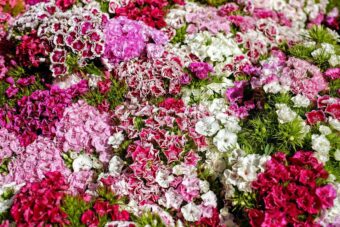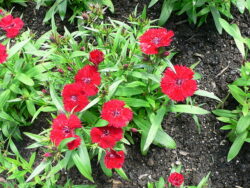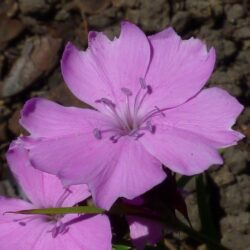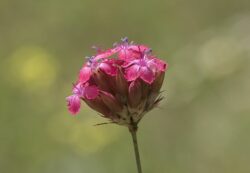In this article, we will discuss how to grow the large genus of Dianthus in containers. It has the common name of pinks or carnation, depending on what species and variety are grown. Dianthus is a large and varied species that include evergreen perennials, biennials and annuals. The common name of ‘Garden Pink’ arises because the scented flowers are all pink but because the flowers are serrated on the edges as if they have been trimmed with pinking shears.

The beloved cottage garden plant has been grown in gardens for centuries. The hardy perennial has pointed, evergreen grey-green leaves that have flowers that come in pink, magenta, red, white, and even yellow. They can be bicoloured and more important they have a lovely clove-like scent.
The compact alpines and dwarf carnations make perfect plants in hanging baskets, window boxes and containers, solely or mixed either with bedding plants, especially in the pastel colour scheme.
Sweet Williams (Dianthus barbatus) is a biennial that can be grown as the sole species in containers, where scented flowers are produced in early summer the following year if bought and plant from seed.
Carnation flowers often do not have a scent but they come in many more colours and they can be grown in containers as sole species.
HOW TO GROW DIANTHUS IN CONTAINERS
First, you must realise that they are not long-lived plants. After a few years after planting they become woody at the base and they become straggly.
You can grow annuals or biennials from seed, but most perennials are grown from shop-bought, garden-ready plants,
Alpine pinks and other pinks can be grown in pots. First, choose a pot that will suit and in dimensions with the Dianthus in question. You can plant multiple pinks in a large container, whilst carnation will need to be planted as the sole specimen in containers.

Dianthus prefer to be grown in neutral to alkaline soil, as they hate acidic soil. Make sure the container selected has plenty of drainage holes and fill it with a 1cm layer of gravel. On top of this mix a handful of lime into multipurpose compost and fill it to near the top.
Dig a hole that is slightly bigger than the root ball in the original container. Drop the plant in so that the top of the root ball is at the same level as the top of the surface of the compost. Backfill with the growing media, making sure that any gaps that remain are filled with more compost. Firm the plant in and water well.
BEST GROWING CONDITIONS
They are quick to establish and should soon give you flowers all summer long. Grow Dianthus in full sun so that they look their best.
Water when 5cm below the surface of the compost feels dry to the touch. Water until it just emerges from the drainage holes. They need to be fed at regular intervals, at least once every fortnight with a high potash liquid fertilizer.
Cut flowers back in autumn, so that they can bloom next year.
A plant that is easily propagated via cuttings. Annuals and biennials will need to be disposed of after they have finished flowering.

Grow Dianthus so that the plant is not competing with other plants as they hate to be overcrowded. Deadhead regularly to encourage further flushes but the problem is that so varieties will only flower once a year.
In autumn, cut all faded blooms and any leaves that look scruffy, Lightly trimming the leaves will encourage new leaves to grow and for the plant to have a better appearance.
PESTS AND DISEASES
Luckily they tend to be pest and disease-free but one major problem is that rabbits love them. You will need to protect them in areas where rabbits are a pest.
Stems will rot if the compost is too wet or if they do not get enough sunlight. You will need to grow them in full sun and make sure the compost is free-draining and never overwatered.
Aphids can be a problem in hot summers, whilst slugs and snails can attack young leaves. You will need to protect the plants from this by using jet water for aphids and pellets for woolly deterrent mats for slugs and snails.
Leaf spots can be a problem with fungal diseases attacking the plant. You can avoid these by making sure there is good air circulation around the plant and that leaves are allowed to dry quickly.
VARIETIES TO GROW
You are very lucky as there are so many varieties that can be grown in containers. The following are varieties to grow in containers:

‘Red Dwarf’ has raspberry-pink flowers that are deeper crimson at the centre and appears from late spring to early autumn.
‘Memories’ have double, white, scented flowers.
‘Sugar Plum’ has double, pink flowers that are creamy white at the edges and has deeply scented flowers.
‘Pop Star’ is an alpine variety with pink, clove-scented flowers that are deeply fringed.
‘Candy Floss’ has pink, double flowers that are heavily fragrant.
‘Tequila Sunrise’ has white, single flowers with a light pink eye at the centre. Produces large blooms that are delightfully scented.
Dianthus carthusianorum has on top of tall stems pink, single blooms.
Dianthus cruentus is a tall alpine with pink-red flowers appearing in late spring and summer.
CONCLUSIONS
In this article, we have discovered how to grow Dianthus in containers. These wonderful scented and colourful plants look good in any container display. Although they may be short-lived lasting only one season, two seasons or maybe five but no matter what they are great plants to have in summer.
They are easy to look after, only require watering, deadheading and feeding when necessary.
If you have any questions and comments that you wish to make on growing Dianthus in containers, please do so in the comment box below.
Happy Dianthus growing.
